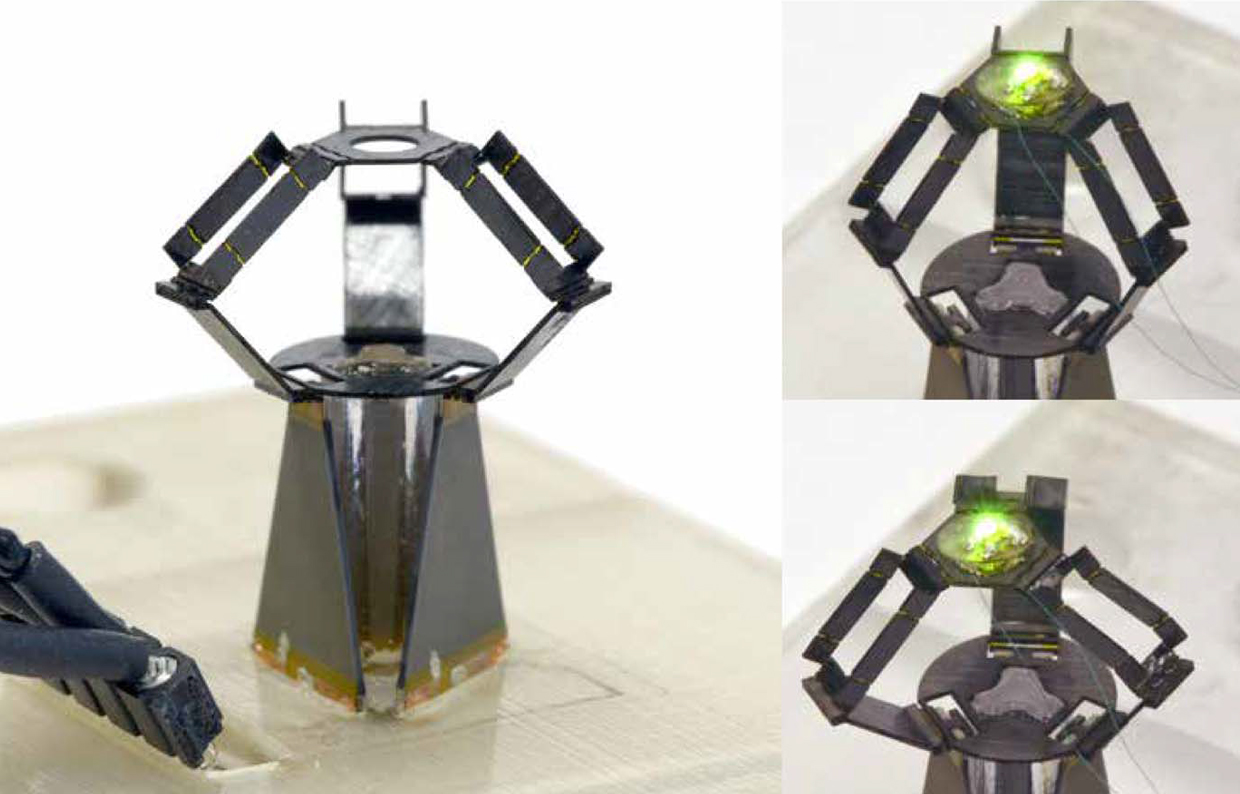The tiny and fast origami robot milliDelta from Harvard surprises with its speed

There are a great many robots. One of the families is delta robots, a kind of parallel robots. Representatives of the family of three levers, which are attached by means of cardan joints to the base. A feature that can be called a key one is the use of parallelograms in the design of the manipulator. This allows you to maintain the spatial orientation of the actuator of the robot. A similar system was first created in the early 1980s by Raymond Klavel.
Recently, another robot created by a Harvard robot at Robert Wood Microrobotics Lab at Harvard by Hayley McClintock was introduced. The system is notable for being the smallest of the delta robots. Its dimensions are only 15 mm * 15 mm * 20 mm, and weight - 430 milligrams. However, it can carry a 1.3 gram payload. The accuracy of the movements of the robot is 5 micrometers.
But the most surprising thing is how fast this robot is able to move: about 0.45 m / s, with an acceleration of 215 m / s 2 .
')
MilliDelta works thanks to piezoelectric drives, which take effect when an electric current occurs. The rest in the design of the robot is a fixed case, created from carbon fiber and additional elements that provide the special properties of the robot. The body is cut by a laser, because to achieve such accuracy when using any other tool is almost impossible.
What can the baby do? For example, to transfer (very quickly) payload, even a very small mass. It can be used in production, for the assembly of various kinds of miniature structures. It can also be used in microsurgery. For example, it would be nice to use it in eye surgery, where it would be most useful.
It is worth noting that Raymond Clavel made his device to work in a chocolate factory. The initial task was to pack small chocolates automatically. Prior to this, the work was performed by people or people "with the support of" semi-automatic machines. In order to achieve his goal, he needed a very fast robot capable of moving without delay.
The first idea of engineers is to work with hydraulic motors as more powerful than everyone else. But they were not suitable for a given purpose, since the candy weighed only ten grams each, and with all its merits, the powerful motor could not cope with such a baby. And then the idea came to use a robot with very light, but at the same time, maneuverable manipulators. It turned out to be a really good idea that continues to evolve today.
The structure of the robot, its design, it was difficult to choose. “I had to work both at home and in the office, and with ordinary things at hand, such as accessories for embroidery. This was required to create a structure that would just work, ”says the creator of the delta systems.
And the solution appeared in the form of a robot consisting of three manipulators that control any object of small size and weight. The idea was successful, and the design was used, if not everywhere, then widely enough. The robot has three translational and one rotational degrees of freedom. The ends of the levers, made of lightweight materials, are attached to a small base. Input connections move the triangular platform in the X, Y or Z direction when moving. The drive can be started using a linear or rotating motor.
In 1987, Demaurex bought a license for a robot, which it used to create packaging. In 1991, Raymond Clavel presented his doctoral work, which was based on the results of tests of robots. In 1999, he received a gold award for his contribution to the development of the delta robot. In the same 1999, ABB began selling a delta robot of its own design.
The miniature robot described above can be used in industry, medicine, science and many other areas. However, for this, its developers will have to spend a little more time commercializing their invention.
Source: https://habr.com/ru/post/374177/
All Articles